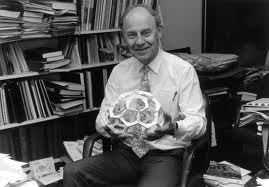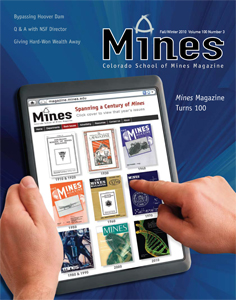 Dr. Dudley R. Herschbach presented a lecture titled “High Pressure Chemistry: Making Gas by Squeezing Wet Rocks”
Dr. Dudley R. Herschbach presented a lecture titled “High Pressure Chemistry: Making Gas by Squeezing Wet Rocks”
Dudley Robert Herschbach, an American chemist from Harvard University, spoke at the Mines Chemistry department as part of their Lucas Lecture Series on April 15, 2011. (Listen to talk via podcast) Herschbach won the 1986 Nobel Prize in Chemistry jointly with Yuan T. Lee and John C. Polanyi for their contributions concerning the dynamics of chemical elementary processes. Herschbach and Lee specifically worked with molecular beams, performing so-called “crossed molecular beam” experiments that enabled a detailed molecular-level understanding of many elementary reaction processes.
Abstract of Talk
Diamond anvil cells can generate pressures greater than those at the center of the earth (3.5 million atmospheres), and laser heating can bring the squeezed samples up to high temperatures (as high as ~2000 C). This talk will be evangelical about pressure as an experimental tool. My prime motivation is to applaud the superb high pressure work led by Rus Hemley at the Geophysical Laboratory of the Carnegie Institution of Washington, and also the prescient proposal of Dmitri Mendeleev that petroleum could be formed deep within the Earth, which acts as a huge pressure cooker. Vignettes to be presented include homages to Evangelista Torricelli and to Percy Bridgman, easy ways to crush railroad tank cars and coax eggs into milk bottles, as well as the chief topic: recent diamond anvil experiments, done at the Carnegie Institution. These demonstrate facile synthesis of methane and higher hydrocarbons under conditions consistent with the P-T regime of the Earth’s mantle at depths of 70-150 km.
Herschbach was born in San Jose, California. After graduating from Campbell High School, Herschbach received a B.S. in mathematics in 1954 and an M.S. in chemistry in 1955 from Stanford University, and an A.M. in physics in 1956 and a Ph.D. in chemical physics in 1958 from Harvard University under the direction of Edgar Bright Wilson. After graduation, Herschbach joined the University of California at Berkeley, where he was appointed an Assistant Professor of Chemistry in 1959 and became an Associate Professor in 1961.
In the course of his life’s work in research, Herschbach has published over 400 scientific papers. Herschbach’s research has ranged broadly over the field of chemical physics, including much theoretical work on dimensional scaling. His most acclaimed work, for which he won the Nobel Prize, was his collaboration on crossed molecular beam experiments with Yuan T. Lee. Crossing collimated beams of gas-phase reactants allows partitioning of energy among translational, rotational, and vibrational modes of the product molecules, a vital aspect of understanding reaction dynamics. He has applied his broad expertise in the theory and practice of chemistry and physics to diverse problems. A recent study of his demonstrated that methane is in fact spontaneously formed at high pressure and high temperature environments such as those deep in the Earth’s mantel; this finding is an exciting indication of abiogenic hydrocarbon formation, meaning that the actual amount of hydrocarbons available on earth might be much larger than conventionally assumed under the assumption that all hydrocarbons are fossil fuels. His recent work also includes a collaboration with Steven Brams studying approval voting. Hershbach’s teaching ranges from graduate seminars on chemical kinetics to an introductory undergraduate course in general chemistry that he taught for many years at Harvard, and described as his “most challenging assignment.”
Herschbach has been a strong proponent of science education and science among the general public, and frequently gives lectures to students of all ages, imbuing them with his infectious enthusiasm for science and his playful spirit of discovery. Herschbach has also lent his voice to the animated television show The Simpsons for the episode “Treehouse of Horror XIV” where he is seen presenting the Nobel Prize in Physics to Professor Frink.



